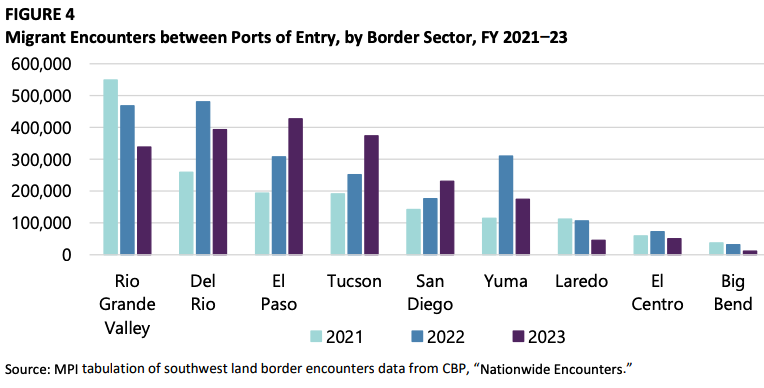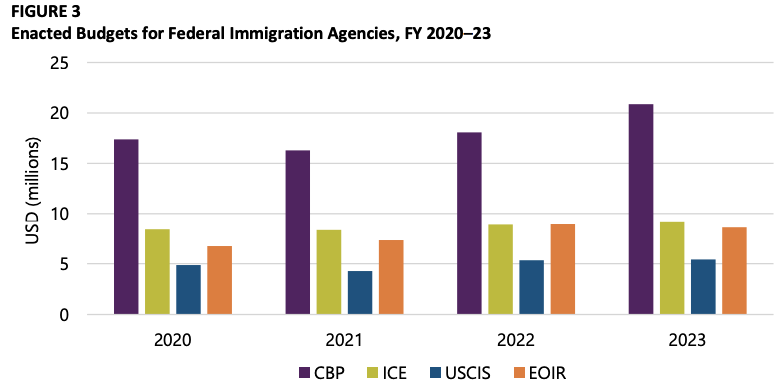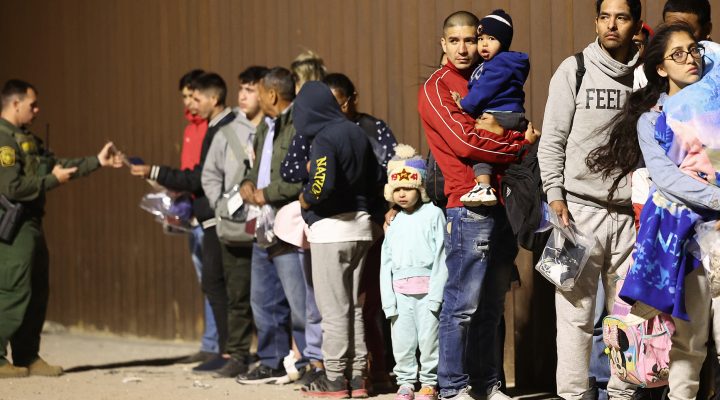The tide of migrants seeking entry into the United States cannot be stemmed with border security measures alone, the Migration Policy Institute reported in a new study.
Migrant encounters at the United States’ southern border reached a record 2.5 million in 2023, despite Biden administration rules designed to reduce asylum and require migrants to remain in Mexico as immigration cases are processed. Congressional Republicans are proposing harsher versions of those directives.
The Migration Policy Institute is a nonpartisan organization that “seeks to improve immigration and integration policies through authoritative research and analysis, opportunities for learning and dialogue, and the development of new ideas to address complex policy questions,” according to the MPI website.
The Biden administration’s policies “showed some early successes in reducing the pace of migrant crossings and have encouraged more people to arrive at rather than between ports of entry, but overall numbers rose through the end of (fiscal year) 2023,” MPI said in the Jan. 11 report.

“In turn, the growing number of migrant arrivals — especially families — being permitted to enter the country to seek asylum and arriving in large cities is outpacing the capacity of support services to provide adequate housing and support their self-sufficiency, fueling federal–state–local political tensions.”
The situation has stretched the nation’s border management agencies far beyond their capabilities, forcing them to react to perpetually shifting and surging waves of arrivals. As a result of such conditions, migrants routinely are subjected to arbitrary processing decisions, asylum seekers are not adequately screened for eligibility, and Mexican and U.S. border communities, municipalities and nongovernmental organizations are overwhelmed, the report said.
Simply beefing up the ranks of U.S. Customs and Border Protection officers, building walls or installing razor wire along the Rio Grande will not adequately address the challenge.
Simply beefing up the ranks of U.S. Customs and Border Protection officers, building walls or installing razor wire along the Rio Grande will not adequately address the challenge, MPI noted.
“The study’s findings demonstrate that border control cannot be achieved at the border alone,” it said. “Given current and likely future migration patterns, the border control mission requires substantial resource investments, not just in CBP but also in other agencies involved in migrant processing, including U.S. Citizenship and Immigration Services, Immigration and Customs Enforcement, the Executive Office for Immigration Review and the Office of Refugee Resettlement.”
The MPI study acknowledged several areas of progress in some immigration programs, including the federal government’s much-maligned CBP One app.

Migrants waiting in Mexico must use the smartphone application to request appointments at designated points of entry. The U.S. government introduced the app in 2020.
“At the outset, the app faced many well-documented problems, including frequent crashes, difficulties with its biometric live photo capture feature and appointments filling up nearly instantly,” the MPI report said. “The administration has since implemented several changes to address the technical issues and altered the registration process to allow migrants more time to register and confirm appointments.”
Last June, Customs and Border Protection’s Office of Field Operations began processing 1,450 migrants per day through the CBP One app.
“Though that is a record number of migrants processed at (points of entry), the number of appointments still falls far below demand. It is unclear if appointments can be increased, given the other port operations necessary for trade and travel,” the report noted.
But reliance on the app as the keystone of a migrant management system remains problematic, MPI added. “Because it requires a mobile device with access to the Internet, migrants who have a newer phone and reliable access to Wi-Fi find it easier to use than those who do not. People who do not speak one of the three languages offered by the app (English, Spanish and Haitian Creole) or are illiterate also face significant hurdles.”
The study also found that numerous local, national and international partnerships have developed to address migration challenges.
“By providing essential services to migrants who are released from CBP custody, local governments and (nongovernmental organizations) in communities along the border have become necessary partners to federal agencies in reducing economic and social pressures on border communities,” the report said. “Coordinating with CBP, they provide immediate services for migrants screened and released into the United States for further processing and assist them with making travel arrangements to destinations across the country.”
The White House has implemented an immigration framework that includes international cooperation on migration management, the MPI report said.
“Accordingly, the administration has deepened regional engagement and aims to encourage Latin American governments to share responsibility for increasing lawful mobility and protection pathways, expanding migrant repatriation efforts and addressing the root causes of irregular migration,” it said.
Some regional governments are collaborating with the United States to open safe mobility offices to educate potential migrants about lawful pathways to the United States.
Some regional governments are collaborating with the United States to open safe mobility offices to educate potential migrants about lawful pathways to the United States, while the federal government has restarted and increased removal flights to return unauthorized migrants to their countries of origin, the study said.
“As irregular migration has ballooned throughout the Western Hemisphere, the need for shared responsibility and collaboration, defined not only by heightened migration controls and enforcement but also by access to lawful mobility pathways, is increasingly evident,” it added.
But more is needed to handle the anticipated surge in migrants headed to the United States, the study said. “More than half a million people crossed the treacherous stretch of jungle between Colombia and Panama known as the Darién Gap in 2023, and early projections suggest migration in 2024 could match that record.”
A viable and humane response will require more interagency coordination, funding and innovative policymaking geared to the changing migrant arrival patterns.

MPI suggested several solutions, including opening interagency processing centers at the border to determine when migrants should be removed or allowed to enter the country. Another is to strive for an asylum system that offers fair and timely decisions.
“Migrants currently permitted to enter the United States to pursue their asylum claims will wait years for decisions on their cases,” the report said. “Such delays deprive those eligible for asylum from gaining protection and being able to start new lives, and undercut deterrence of unauthorized migration by encouraging others to file weak claims as a way to stay in the country while their cases sit in the backlog.”
The Office of Field Operations should be funded adequately and staffed so that it can carry out CBP One processing at levels to meet demand, the study said. Public-private partnerships between nongovernment organizations, local governments and Customs and Border Protection should be made official.
“At best, these systems are ad hoc and prone to lapses in communication,” the report observed. “These partnerships should be formalized to allow for data sharing, including daily numbers of migrants, nationalities, medical conditions and vulnerabilities. This would enable NGOs in destination locales to better prepare for migrant arrivals.”
Without change, migration will continue to overwhelm the federal agencies working to address it, MPI said.
“Without such efforts, managing migration at the southwest border will continue to be a reactive exercise, rather than a cohesive strategy that proactively identifies migration patterns and responses across the region and addresses migrant protection needs and border control imperatives.”
Related articles:
Evangelical Immigration Table urges Congress to consider what Jesus would do
Immigration advocates furious with Biden administration and House Republicans
Tougher border policies will not stop the flow of migrants, immigration experts say
Attempted ‘border security’ amendment would have been fatal, immigration advocates say


